
This month, the UKC/UKH Team have mostly been testing camping mats. Everyone was looking for something different: Alan wanted a super comfy mat so he could enjoy two weeks of family camping in France despite a bad back; Jack wanted something more luxurious for climbing trips that didn't demand a fast and light ethic; Sarah wanted to test a warm and versatile female-specific mat - specifically female-specific not just a 'pink female colourway'; Mick wanted something superlight and innovative to take on a mountain marathon; and Dan was off bivvying under a tarp and the stars. Here follows what we came up with...
Reviewer: Alan James, UKC/UKH Director
What he was looking for: "Age and back problems have both been catching up with me in recent years. I needed two weeks of restful nights on a family camping trip in the south of France..."
The Alpkit Dozer is the big mother of sleeping mats, extra thick, extra comfy, designed for those with dodgy backs or special sleeping requirements. At 7.5cm thick it is a sizeable slab of comfort, but obviously this comes at the price of bulk - you aren't going backpacking with this one!
Alpkit Dozer
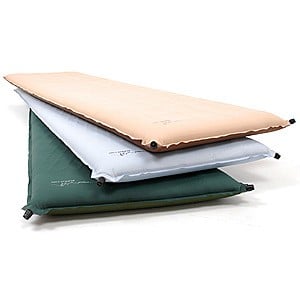
Real World Packed Weight (gr): 2009
Dimensions (cm): 195 x 60 x 7.5
Min Rolled size (cm): 66 x 18
Realistic Rolled size (cm): 66 x 22
More details: Alpkit website
Age and back problems have both been catching up with me in recent years and I have to admit that the old top-of-the-range mat we had wasn't really doing the job for me any more. Waking up and taking 10 minutes to unwind and straighten up after tossing and turning all night isn't a great way relax and holidays are supposed to be all about relaxing. So I gallantly volunteered to test drive the Alpkit Dozer on our extended camping trip to the south of France. After two weeks of very restful nights I am happy to report that this mat is a major improvement.
"...This all packs into its own stuff sack with compression straps making it tidy but still not compact enough to take backpacking - shame!"
The secret I find with these mats is not to over-inflate, and never to store them rolled up. After I had unpacked the Dozer it took a while to inflate itself, in fact the first time I needed to give it a bit of a boost with my own puff (probably stored by the Alpkit crew rolled up - tut tut!). After that though it has been fine and now self-inflates to exactly the right level without an extra puff required. Avoiding blowing the mats up helps stop them getting moisture and algae build up inside them which can rot and weaken then internal foam.
Deflating can be a chore with the bigger mats and that is where the Dozer's mats 'extra feature' comes in. It is equipped with two valves which makes it slightly quicker to deflate although in practice against another big mat there was not much difference to be honest. This all packs into its own stuff sack with compression straps making it tidy but still not compact enough to take backpacking - shame!
Summary
So that's about it. A great mat for car camping which gives the best comfort level you will find and at a very attractive price. It is available in three colour schemes for those who wish to match it to their sleeping bags.
Reviewer: Mick Ryan, UKC/UKH Advertising Manager and Senior Editor
What he was looking for: "I've been enjoying getting into fell racing recently, and with a bit more training will be looking to compete in a marathon. I was looking for something super lightweight and innovative..."

I was reminded of my Duke of Edinburgh award expeditions a few weeks ago on a wet and windy day in Langdale. There they were, a troop of teenagers trogging along the road weighted down with Vango tents, various pots, pans and meths stoves, leaky ponchos and those unwieldy spongy Karrimats dangling from their huge canvas rucksacks. They looked miserable. I joked in an evil way to them that they had miles to go and that the rain was only going to get worse.
I'd been there: bronze, silver and gold, on Dartmoor, in the Yorkshire Dales and in the Lakes; wet, cold, lost and miserable, looking like a tramp carrying all my wordly possessions. Feet sodden and blistered, lower back and shoulders sore from carrying far too much heavy gear and there was no relief when the tent was pitched and we were lying in a damp synthetic sleeping bag on a spongy wet karrimat in a pool of water. Our matches were sodden and we couldn't light the stove. The night was never ending, hunger ached at our bellies and sleep rarely came. Character building stuff.
"...A space age sleeping mat, it is a series of inflated connected tubes with big chunks missing. The theory here is called body mapping..."
Whilst outdoor gear technology has moved on considerably it seems that nearly 30 years on schools are still issuing the same kit as they did in the early 1980's. My pet hate was always the old foam Karrimat; it was bulky, hard to attach to an already over-packed rucksack and you could never get a good nights sleep on it. When I got my first inflatable sleeping mattress, a Therma-a-Rest, it was a revelation, I had my first comfortable night in a tent. The early Therma-a-Rests were bulky but the trade off was worth it for a good nights kip. Now you can get lighter models that pack small but none as small as the mat I was issued with for this review, the Klymit Inertia X-Frame Sleeping Mat.
A space age name for a space age sleeping mat, the Klymit Inertia X-Frame Sleeping Mat is an odd looking beast, it is a series of inflated connected tubes with big chunks missing. The theory here is called body mapping. The mat only gives support where you need it, at your bodies pressure points; your feet, calves, hips and buttocks, your upper back and shoulder and your head. This parred down designs explains why this mat is so light and fits into a stuff sack the size of a coke can.
It took four or five breaths to inflate to a comfortable pressure - normal inflatable mats because of their higher volume take 30 or so breathes, to inflate further you use a small hand bulb pump that is provided. It takes a minute to inflate fully.
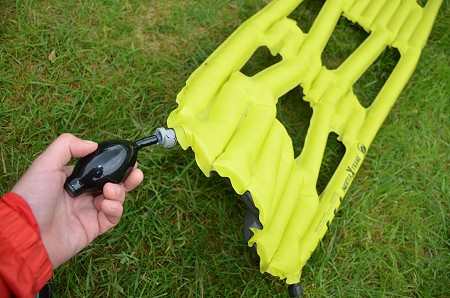
The other important feature is what they call loft pockets - these are the spaces between the inflated tubes. In normal inflated mats you will compress the down in your sleeping bag flat against the inflated mat which will lose you some insulation. With the loft pockets (holes!) of the Klymit Inertia X-Frame Sleeping Mat much of the base of your sleeping bag is not compressed but drops into the spaces and maintains its loft and hence insulation.
I'm a smidgen over 5ft 10 inch, if you were taller this mat may be a touch small at 6ft in length to give you full coverage, width is 18 inches when inflated, ample for the average person. Klymit do do a larger mat, the Inertia XL for larger people
This is a preliminary review. My friend Greg Rimmer is taking the mat with him on next weeks Lowe-Alpine Mountain Marathon in Scotland to give it a thorough testing in real life conditions where lightweight kit really comes into its own. This really is a piece of gear that will be of great interest to the light and fast (or slow) brigade. Actually scrap that, this will be of interest to anyone who camps.
I'm a bit sad I have to pass this onto Greg. It's a revolutionary piece of gear, everyone I have shown it to has gone, Wow! At £80 is represents good value for money compared to other inflatable mats. Its light weight (301g or 10.6 oz with the bulb pump) and small packable size is incredible, and it is as comfortable as my reliable Therm-a-rest, if not more so. It is claimed to be robust too, with a ripstop 30 dernier top and 75 dernier bottom, with a burst pressure of over 10psi. Every DofE'er should be issued with one.
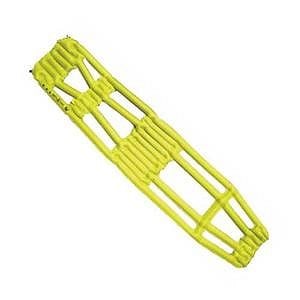
Klymit Inertia X-Frame
Weight: 258g without bulb pump
301g with bulb pump
Dimensions: 1829mm x 457mm x 38mm
Packed size: Same size as a drinks can!
Top fabric: Lightweight 30D Ripstop Nylon
Bottom fabric: Durable 75 D Polyester Colour: Chartreuse Neon Green with Charcoal Grey Base
More details:
Beta Climbing Designs website
Reviewer: Jack Geldard, UKC Chief Editor
What he was looking for: "When alpine climbing, I never use an inflatable mat as sharp crampons don't partner them well - I always use a normal foam mat. But away from the mountains, and close to the car I want something a bit more luxurious for regular camping trips..."
The Nemo Tuo Luxury is by far the best inflatable camping mat I have ever used. That is a fact! The mat is a beast, almost airbed-like in size when inflated, and just as comfortable. It isn't a superlight, super small, backpacking mat, but it isn't ridiculous when packed away. After using the mat, I personally would carry the extra weight on most camping trips in order to get the comfort I need.
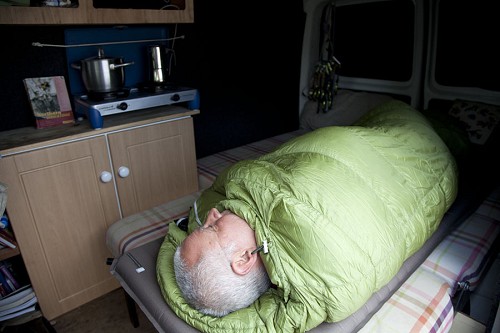
I never use an inflatable mat when alpine climbing, as sharp crampons don't seem to partner them well. This mat is no exception, and is also far too large for carrying on routes.
The mat weighs in at 1.6kg and packs down to a reasonable size (see photographs). When rolled up at full width (it is folded in half in the photos, and is therefore twice as fat) it is about half the 'fatness' of an average foam rollmat, so can easily be strapped down the side of a pack.
It is actually two mats in one - the two mats are on top of each other. A tough mat goes against the ground, and is inflated very firmly, giving puncture resistance. The upper mat can then be inflated quite softly giving comfort that is easily adjustable. Each mat has its own valve for simplicity.
You can adjust the firmness of the mat whilst laying on it - the valve is right next to your head and within easy reach. It has a bite system to control the valve whilst inflating the mat which worked well and intuitively.
The build quality is excellent. The size of the mat was ideal for me as I'm 6ft 2 and the mat was approx 6ft 3 long and 2ft wide. The mat comes with its own stuff sack and a puncture repair kit.
In short:
- Not the lightest mat on the market, but still very carryable.
- Far and away the most comfortable camping mat I have ever used. More comfortable than sleeping on two bouldering pads.
- Very high build quality and design spec.
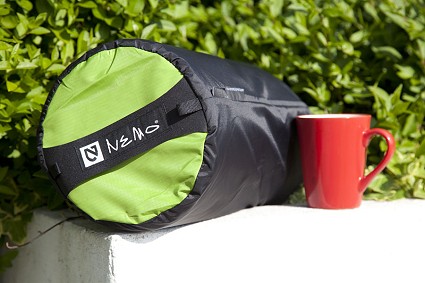
Nemo Tuo Luxury
Size (cm): 193 x 64 x 5.8
Stuff Sack: Yes
Shape: Rectangular
Stuff Size: 32 x 18cm
Sleeping Pad Type: Manual Inflating
Weight: 1.6kg
More details: NEMO website
Reviewer: Sarah Stirling, UKC/UKH Editor (Gear and Features)
What she was looking for: "I was looking for warmth, versatility and real 'women-specific' features as opposed to just a girly colourway..."
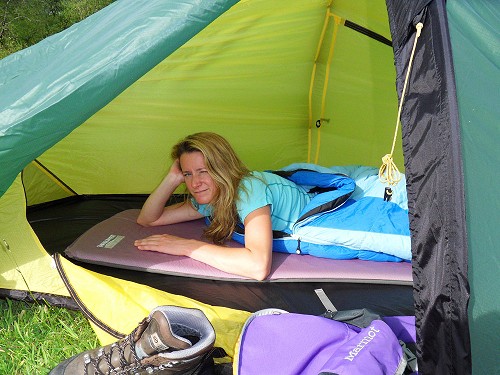
Women generally sleep colder than men. EN sleeping bag ratings reflect this: offering different comfort/lower limit recommendations for women than for men, and now most brands offer 'women-specific' sleeping bags. But what about sleeping mats, are they following the women's rights outdoor gear revolution? Some are - and some more than others - does a 'pink female colourway' make an item women-specific?! Therm-a-Rest seem to be leading the charge in camping mats for women proper.
'Four season' can be a misleading term in camping gear: three season sleeping bags and tents actually being more practical for more seasons than four season ones. However, I figured 'four season' really does mean four season in camping mats. A bit of extra padding can never be amiss, can it? ... and you can sort of balance the extra weight/warmth by carrying a lighter sleeping bag in hot weather if your mat is a good insulator. I hoped it would prove a versatile mat that I could use both for summer trips and winter ski touring.
First impressions?
Therm-a-Rest Women's Prolite Plus
Weight: 680g
Size (cm): 168 x 51 x 3.8
Pack size (regular): 28 x 12cm
More details: Cascade Designs website
Typically you open the valve of a self-inflating mat and leave it in your tent for a while: hey presto. If you've stored it rolled up rather than inflated, however, it can take around 24 hours for the foam inside to regain its memory. And lighter mats have less bounceback than ones with denser foam inside anyway. Plenty of reasons not to be patient: I puffed the mat up by mouth and lay on it. Mats are usually more comfy if there's some give to the contours of your body. Handily the valve on the mat was located at the top, so I let some air out while laying on it. Both sides of it are non-slip.
So how's it women-specific? Firstly it's purple - sort of girly but not patronisingly pink - and quite short. I'm 5'4" (163cm) and it's 168cm, which fits me perfectly when I'm lying on my back. It's shorter than the unisex version (which is 183cm in regular size) but the same width, which is ample enough to accommodate a foetal sleeping position, so taller women could be completely insulated from the ground. (The women's version only comes in this one size, but the ProLite Plus unisex is available in three sizes). It's also noticeably warmer to sleep on than the unisex version (which has an R Value of 3.8) because it's got more inside it.
A word about the technology
The Prolite Plus range is interesting in that they're thicker than their Therm-a-rest Prolite 4 predecessors, but not heavier. How? The new mats feature 'patent patent-pending foam-perforating technology'. In English: they made them thicker but cut holes out of them.
To make a self-inflating foam mattress lighter, you use less foam. Therm-a-rest's technique is to cut 'plugs' out of the foam, using special die cutters that they've had built for their manufacturing machines in the Seattle, USA and Cork, Ireland factories. Cutting out the foam, however, can also decrease the insulation and warmth. So, they cut the 'plugs' out diagonally so there's always foam beneath you. (The plugs they take out of the mattresses are used to fill their Therm-a-Rest Compressible Pillows - clever!). The women's model features more insulation (i.e. less plugs taken out) in the foot and torso areas, where women tend to lose their heat first.
Any downsides to the mat?
Despite being significantly shorter than the unisex version, it weighs the same: 680g. It is warmer though. Secondly it doesn't pack that small: my luxurious Exped DownMat 7 Pump has an R-Value of 5.7 and packs to 23x16cm - this Therm-a-rest packs to 28x12cm. Not a great difference. It is 200g lighter than the DownMat though.
Reviewer: Dan Bailey UKH Editor (News)
What he was looking for: "I'm usually a bit of a princess and the pea type and was looking for something to add a bit of luxury to bivvying..."
And so to bed. Since I was 14 a thick winter weight Karrimat has gone with me on practically every camping trip, and it's still going strong after more than 20 years. It must be the best purchase my Mum ever made, and I was a little reluctant to part with this utterly reliable security blanket. But rolled up it is huge, stuck on the outside of the pack catching the wind and sticking in chimneys when climbing. On the other hand I've tended to be sceptical of inflatable mats of all makes, and have not had a great track record with punctures and leaky valves to date. But after only one night with the Synmat UL 7 I was a firm convert to cutting edge comfort...
Read Dan's Gear Article 'The Bearable Lightness of Bivvying' here.




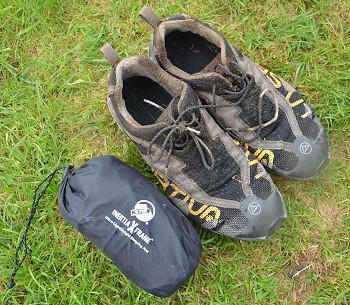

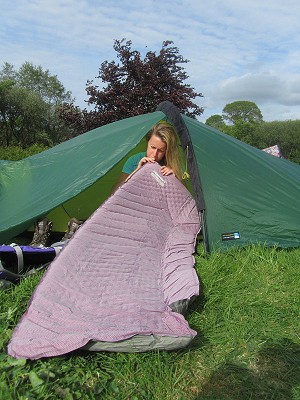
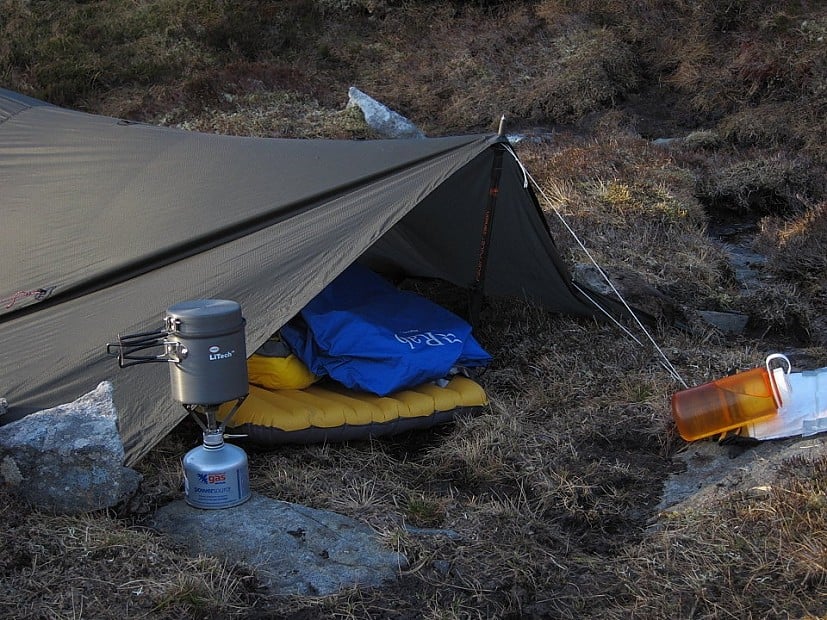

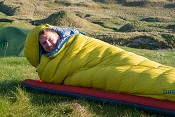
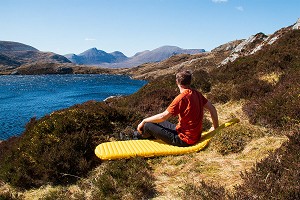





Comments